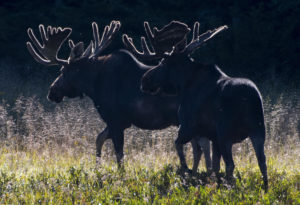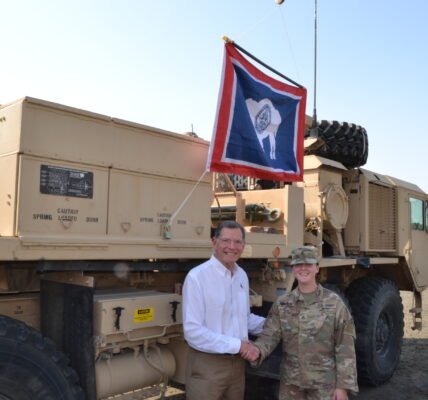By Mark Davis, Powell Tribune
Via- Wyoming News Exchange

POWELL — By the time the sun began illuminating tree-covered peaks, Sam Stephens was already in hot pursuit of a cow moose near Shell.
Before 5 a.m., his green company truck was packed and Stephens — the new Greybull area wildlife biologist for the Wyoming Game and Fish Department — was on the road sporting a crisp, red shirt.
By 7:15 he had met with a group of scientists, technicians and game wardens while a beautiful, mature cow calmly munched foliage on a steep hill less than 600 yards away. Stephens broke away from the group to attempt to dart the moose. He and his team had one collar to deploy in the area — the last on the western side of the Bighorn Mountains in the first-ever study of the species in the region.
With a camo tranquilizer gun in one hand and a rangefinder in the other, he quietly descended to a small grove of trees and brush between him and the 700-pounder. Before he could get within 100 yards, her giant ears were already back and aware of Stephens’ every step.
Crossing a small meadow, the moose took just a few long strides and was breaking away. Moose are deceptively fast. Stephens wouldn’t give up easily, though. He moved quickly, staying low and carefully maneuvering through brush. But the moose got out of reach before a dart could hit its target.
As part of a study that started in 2017, Stephens’ job on Wednesday was to lead a team to place the last of 11 GPS collars on moose in the western portion of the Bighorn Range. The collars were to replace several which malfunctioned or were on a moose that didn’t make it through the harsh winter. Collars deployed last year were the first ever in the Bighorn population. There’s not a lot known about Bighorn Mountain moose, Stephens said.
Spending most of his life dreaming of adventurous Wyoming hunts — watching endless hunt videos and wildlife features — Stephens is living a dream he’s had since growing up in Worland. “I was always pretty motivated to get out hunting, fishing, camping and spending as much time in the woods as I possible could,” he said.
Stephens had help. His father, Tim, is a wildlife biologist for the Bureau of Land Management. He also loved to watch Steve Irwin, the Crocodile Hunter. As a result, Stephens grew up enamored with all wildlife and often went out of his way to see them. “This is a dream job for me.”
Soon after his first attempt, Stephens found another candidate a couple miles down a dusty road in a clearing. She was bedded down and barely visible while the three large males munched on willows near a creek. Before Stephens could fire a shot, the cow headed for relative safety among the bulls, still in velvet. The biologist once again was forced to give up the chase.
There was only a small window to get the job done Wednesday. It’s dangerous for a moose to become overheated, requiring pursuits to take place in the early morning hours. The team decided to drive deep into the backcountry, finally locating a cow browsing tender plants from a lake, deep inside the Bighorn National Forest. Just getting to the moose was a chore — bouncing down rocky roads to the lake. Now it was a waiting game.
Stephens couldn’t dart the moose while in the water. He took a position on the ground next to a fence and waited. Between bites, water cascaded down her long nose as she picked tender bits from the bottom of the lake. It’s obvious how collars can malfunction, said Lindsay Martinez, a graduate student at the University of Wyoming who’s charged with analyzing data and following about 60 collared moose.
Since beginning the study, 16 collars have had to be replaced, Martinez said. “They dunk their heads under the water and endure all kinds of weather,” she said of moose. “There’s usually some failures.”
Martinez is doing her master’s thesis on the demography and habitat use of moose in the Bighorn National Forest. Just getting the study off the ground took nearly a decade, she said. “We finally got the funding and everything in order to get the project going.”
Once funded, the hard work began. Getting in position to dart a moose is difficult. The shooter needs to be about 30 to 35 yards away to get off a good shot. Some moose make it easy, but many are in tall ground cover and aren’t keen to let Game and Fish get too close — especially when they have calves.
Females typically select the higher quality habitat and are a better indicator of the population, Stephens said. The study will help determine recruitment rates as well as how they travel through the region. The 60 collars represent as much as 20 percent of the population, though there has never been a thorough count of moose in the Bighorns. “We can speculate there are between 300-600 moose in the Bighorns,” Stephens said.
Getting an accurate count is difficult, Martinez said. “There’s a lot of dense forest areas and finding them is really tough.”
The Game and Fish monitors the Bighorn population using a trend count, which gives a known minimum and indicates whether the overall population is growing or in decline. “Our 2018 trend count was 169 moose — though this is only a sample of individuals that were physically seen,” Stephens said. “The actual Bighorn Mountain population is likely much larger.”
There were five mortalities among the moose previously collared. One was hit by a vehicle and another died of old age, Martinez said. Of the others, there was no evidence of predation. Winters are harsh in the Bighorns.
Though there are mountain lions, black bears and a few reports of wolves in the area, very few predators are strong enough to bring down a mature moose — and there have yet to be any reports of grizzlies in the range.
“We don’t have established populations of grizzlies or wolves in the area — the two main predators of moose in Wyoming,” Stephens said.
As tough as it is getting all 60 collars deployed, the job gets tougher in the winter. Martinez and seasonal technicians brave weather in February and March, often traveling by foot to collect fecal samples. Progesterone levels are then tested to see if the collared moose are pregnant. Martinez has also set up about three dozen scout cameras in creek bottoms, where moose like to forage. Getting to the cameras requires using snowmobiles, skis and snowshoes. It also requires patience. Weather dictates when teams can get out and Martinez lives in Laramie. “Many times the roads were closed for weeks on end and we had to change plans,” she said. “Safety in the mountains is key.”
Moose rely on willows throughout the year. Another component of the study is to monitor willows in the forest. Martinez hopes to hire technicians to stay in the mountains through the winter to help collect data.
When the target moose finished her meal, she made her way back to shore. Stephens lined up his shot and placed the dart perfectly in her hind quarters. She wasn’t happy and started to walk toward the woods on the north side of the lake. Stephens followed carefully, staying at least 100 yards behind, not wanting to spook her. The cow finally laid down near shore, about a half-mile from the team, which rushed in to perform blood and fecal tests and to install her new collar.
Josie Kerrigan, of White River Junction, Vermont, and Travis Coats, of Austin, Texas — seasonal technicians working with the team — took their positions at the front and rear of the moose. Kerrigan held the head up, gently caressing her jowls. The head was as big as Kerrigan’s entire torso.
“It was pretty amazing. How many people can say they held a moose?” she said. “From afar you can see they are big animals. But when you’re holding it, you think, ‘Oh my God, this thing is massive.’ It’s unbelievable.”
The tranquilizer used doesn’t put the moose to sleep, rather immobilizing them for a short time. It’s safer for the moose, which are surprisingly fragile for their size.
Coats had the job at the other end collecting fecal samples.
“Despite being on the back end, it’s fun to put on gloves and take part in science,” he said.
Soon the tests were done and Stephens gave the moose its collar, number Y17. As the cow started to regain its senses, the team removed a jacket that had covered its eyes while it was handled and slowly backed away. Soon the moose stood, turned and looked at the group — and immediately put its ears back. The group moved a little faster back to the trucks at the sign the newly collared moose was annoyed with her encounter.
Martinez and Stephens will begin to analyze data next year, hopefully revealing secrets and giving clues to the management of the moose of the Bighorn National Forest.







